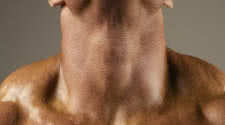Pencil-Neck Bodybuilder - How to Improve your Neck Muscles

A Well Balanced Bodybuilder Trains all Muscles
The idea of never training the neck to make you shoulders look wider is false! That's like saying if you don't train legs, your upper body will appear bigger. The neck is one of the easiest bodyparts to train, so let's get to work on it. I am going to outline some exercises you can do in a commercial gym and then another one for use at home.
Commercial Gym
Using a neck-strap harness and the low floor pulley cable on a crossover unit, seated cable rowing or preacher cable machine, you can do the following exercises:Exercise No. 1 - Put the neck-strap harness on your head. Sit on a bench while facing the low floor pulley cable and attach the cable to the neck strap. Move your head from the chin-on-chest position to an extreme backward extension (posterior flexion) and then forward.
Reverse your position and neck strap so that you are sitting with your back to the low floor pulley cable. Move your head from the extreme backward extension forward to the chin-on-chest position (anterior flexon) and back.
Exercise No. 2 - On this exercise readjust the neck-strap harness on your head and sit sideways (right side of the body facing) to the low floor pulley cable. Pull your head from your right shoulder to the left (lateral flexion) and back.
Reverse the position so that you are sitting sideways (left side of the body facing) to the low floor pulley cable. Pull your head from your left shoulder to the right (lateralflexion) and back.
Home Gym
Sit in a sturdy chair and put the harness over your head with the weight in front of you. Lean your upper torso forward and brace your hands on your upper thighs. Starting with your chin down on your chest, move your head to an extreme backward extension and then forward.To do the next exercise, stand up and reverse the neck-strap harness to put the weight behind you. Hold the harness so that it doesn't slip off your head, but don ft use your hands to assist the actual movement. Beginning with your head as far back as possible, move it forward to touch your chin to your chest and then back. Neck Bridges - Lie on your back with your head on the floor. You may use a pillow under your head for comfort if need be. Now bridge by arching your back completely off the floor. Your feet should be directly under your knees. Rock back and forth from the crown of your head as far toward your forehead as possible. Lower yourself until your back touches the floor. This is one of the most effective ways to build up the back of the neck.
One of the best ways to work the front of the neck is to lie flat on your back on a bench with your head extended over the end of it. Lay a folded towel on your forehead for padding and place a barbell plate on top of it. Holding the plate with your hands, and through neck action alone, lower and extend your head as far back as possible (posterior extension). Smoothly raise your head upward and toward your chest to achieve anterior flexion, thereby working the front of the neck.
You can work the neck with partner-assisted human-resistance movements (anterior, posterior, and lateral flexions). I am not very impressed by this method because of the sometimes wide disparity of resistance applied through the various rep cycles by a partner.
There are, of course, other more advanced exercises such as head stands with your feet against a wall, prone (face down) and supine (face up) neck and body supports between two chairs, but the ones I described will do nicely for now. Don't try to include all these exercises in one workout, but select one or two different ones (3 sets x 12 to 15 reps of each) for each neck-training session. You will enjoy the variety and your neck will respond better.
These suggestions should put an end to your neck that looks like a stack of dimes and give you a column-like neck of a bull (which you are full of by the way).